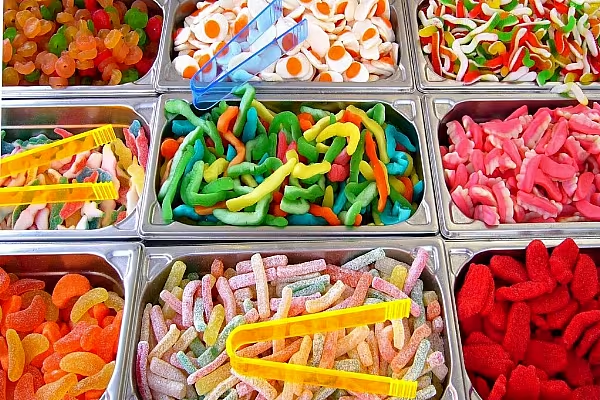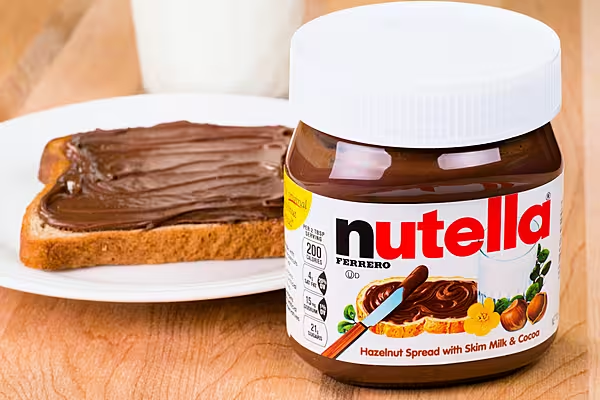The coronavirus pandemic has altered consumer shopping habits over the past year, but what effect has it had on confectionery sales? This article first appeared in ESM Issue 6 2020.
While in many markets, the COVID-19 crisis has done little to curb consumer demand for sweet treats, the performance of several Confectionery categories before, during and after lockdown measures presents an interesting outlook for the sector, particularly during the current ‘second wave’ restrictions.
That’s according to new data from IRI (www.iriworldwide.com), which has tracked the performance of the various confectionery categories across seven key European markets – Germany, France, Greece, Italy, the Netherlands, Spain and the UK – since the start of the year.
Germany
As the home of iconic brands such as Haribo and Ritter, Germany is the number one country in Europe for candy, with a market worth €6.47 billion in 2019.
As of the end of 2019, the Total Chocolate and Total Candy categories had both seen year-on-year growth, of 5.8% and 3.2% respectively – the former category saw a surge in sales for Chocolate/Nut Bars, up 10.2% year-on-year. This growth continued in the early part of 2020, with the period up to the start of lockdown (on 23 March) seeing Total Chocolate up by 14.2% year-on-year and Total Candy up 5.0%.
The lockdown period, which ran until 10 May, slowed this growth, although some subcategories outperformed. In Total Chocolate, which grew by 0.6% during lockdown, the market for Chocolate Blocks/Shapes fell away (-6.4%) while Chocolate/Nut Bars accelerated (+17.8%). In Total Candy, which was down 1.8% overall, a number of categories fell back – Sweets were down 15.7% (compared to 1.6% growth at the start of 2020), while Chewing Gum fell by 28.5% (compared to +2.9%).
In the period from the end of lockdown to 23 August, most categories saw a revival – Total Chocolate was up 11.8% with Total Candy up 0.5% – however some subcategories have found the going tougher. Marzipan / Nougat was down 41.8% in the post-lockdown period, while Chewing Gum was down 17.5%.
France
Going into 2020, the performance of the French confectionery sector was mixed – as of the end of 2019, the Total Chocolate market was worth €2.49 billion, a 1.3% increase on the previous year, while the Total Candy sector was valued at €1.45 billion, a 1.1% decline. In the months leading up to lockdown, both sectors saw growth, however: +4.4% for Total Chocolate and +0.8% for Total Candy.
The lockdown period, which ran from 16 March to 10 May, saw this divergence of the two main sectors magnified, as Total Chocolate saw a 19.6% increase, and Total Candy dropped by 23.5%. Within Total Chocolate, Chocolate Bars were they key growth driver, seeing 39.7% growth, while Chocolate Confectionery dipped marginally (-2.3%). The Total Candy sector, meanwhile, was weighed down by the performance of Small Sugar Confectionery (-47.6%) and Chewing Gum (-49%).
After lockdown, in the period from 11 May to the end of August, the Total Chocolate sector maintained above average growth, of 9.6%, while Total Candy has turned the corner but is yet to return to growth (-7.2%). Again, weighing on the Total Candy sector in the post-lockdown period are Small Sugar Confectionery (-16.4%) and Chewing Gum (-16.3%), both of which are a good bit off their performance as of year-end 2019.
Greece
The COVID-19 pandemic significantly impacted Greece’s tourism sector, but when it comes to the country’s confectionery industry, there were both winners and losers, IRI indicates. As of the end of last year, Greece’s Total Chocolate sector, which is worth €100 million, posted sales almost exactly in line with the previous year (+0.1%), while Total Candy sales were up 4.7%. In the run up to the imposition of lockdown measures, Total Chocolate had got off to a sluggish start to the year
(-3.0%), while Total Candy posted 4.1% growth. All that would change, however, in the weeks that followed.
In the lockdown period, which ran from 10 March to 4 May, the Total Chocolate sector surged by more than a fifth (+22.4%), with Chocolate Tablets seeing a 28% increase. In contrast, the Total Candy sector saw a 8.1% decline, with Lollipops (-22.9%), Chewing Gum (-22.8%) and Pralines (-8.2%) seeing the biggest declines.
Notably, the emergence from lockdown has seen a continuation of these trends – in the period from 27 April to 23 August, Total Chocolate was up 16.1%, while Total Candy’s losses accelerated to -8.5%. The Chewing Gum segment (-16.8% in the post-lockdown period) continues to weigh on the sector.
Italy
Italy was the first European country to be affected by COVID-19, and thus was a forerunner of many of the early-pandemic trends seen in other markets – the rush to stock up on toilet paper, for instance. However, as IRI shows, the country’s confectionery sector found the going somewhat challenging.
As of the end of 2019, the Total Chocolate market was up year-on-year by 0.8% (to €885.6 million), while Total Candy rose by 1.3% (to €1.11 billion). The initial months of 2020 also showed promise, with Total Chocolate rising by 2.1% and Total Candy up 5.1% in the months prior to lockdown.
The lockdown period, which ran from 9 March to 18 May, saw a reversal of these trends, with Total Chocolate down 18.0% in the period, however Chocolate Bars rose by a third (+33.3%). Total Candy, meanwhile, fell by a quarter (-25.7%), with Chewing Gum (-43.5%) and Torrone, an Italian nougat (-39.8%), seeing the sharpest declines.
Unlike in other markets, government regulations on what products were deemed an ‘essential purchase’ are likely to have impacted the sector.
Coming out of lockdown, Total Chocolate has roared back to life, posting a 15.4% increase in the period from 18 May to 13 September, while the Total Candy sector has remained subdued, posting a 10.8% decline.
The Netherlands
Going into 2020, both the Total Chocolate and Total Candy categories appeared to be in rude health in the Netherlands, with the former recording sales of €505.7 million in 2019, a 8.3% increase, and the latter seeing sales of €414.7 million, a 7.1%. increase. This trend was also visible in the first few months of 2020, with the period before lockdown seeing Total Chocolate and Total Candy up 8.7% and 7.7% respectively.
While COVID-19 lockdown restrictions, which were in place from 15 March to 11 May, did have an impact on the sector, it was not as pronounced as in other markets, as Total Chocolate rose by 4% and Total Candy saw a 3.7% decline. As in many other markets, the Chewing Gum category weighed on the performance of Total Candy, seeing a 26.5% decline during lockdown.
Once lockdown measures were eased, normal service was resumed in the Total Chocolate segment, which was up 6.9% in the period from 11 May to 6 September. Total Candy was 1.8% lower in the period, again weighed down by Chewing Gum (-14.7%).
Spain
Spain saw some of the toughest lockdown measures imposed in Europe, with fines imposed on those leaving their homes for ‘non-essential reasons’, and strict limits on the number of shoppers that could visit a store at any one time. As you might expect, this had an impact on several key grocery categories, including Confectionery. Last year, the Total Chocolate segment reported sales of €528.8 million, a 2.3% increase, while Total Candy was up 3.8% to €1.1 billion. At the start of 2020, this positive momentum continued, with Total Chocolate rising 1.8% in the months prior to lockdown, and Total Candy up 9.4%.
The lockdown period in Spain ran from 14 March to 9 May, and while there were regulations in place on what was deemed an ‘essential shopping trip’, the Total Chocolate category soared during this period, rising by 31.9%, with Chocolate Tablets seeing a 38.6% increase. For Total Candy, the growth was more subdued, at +2.1% – while some categories, such as Gummy Candies (+37.8%) showed growth, others were in decline, with Chewing Gum down 25.3%.
In the post lockdown period (27 April to 23 August), growth remained high in Total Chocolate (+18.5%), with Chocolate Tablets up 20.3%, however Total Candy was pushed into negative territory (-4.0%).
UK
Both the Total Chocolate (+2.3%) and Total Candy (+1.9%) markets were in growth at the start of the year, with the period leading up to the imposition of lockdown measures on 23 March seeing both categories accelerate, rising by 4.0% and 5.2% respectively.
Once lockdown was introduced (running until 4 July), there was little change in the Total Chocolate category (+3.0%), however Total Candy took a significant hit, dropping by a fifth (-20.4%). While some of this can be attributed to seasonality (Seasonal & Gifting Confectionery fell by 24%), Sweets fell by 10.7% (compared to 2.2% growth in 2019), while Chewing Gum dropped by 43.5%.
This negative trend continued once the UK exited lockdown, albeit not at such a significant level – Total Candy was down 9.2% in the period from 5 July to 5 September (with Chewing Gum down 19.1% and Sweets down 8.6%), while Total Chocolate was down marginally in the same period, by 0.9%.
While most of these markets have since entered a second lockdown period, some of the lessons garnered from the first are striking – Chewing Gum appears to have taken the biggest hit of all categories, while in general, the Chocolate segment appears to have outperformed Candy.
© 2020 European Supermarket Magazine – your source for the latest retail news. Article by Stephen Wynne-Jones. Click subscribe to sign up to ESM: The European Supermarket Magazine.














